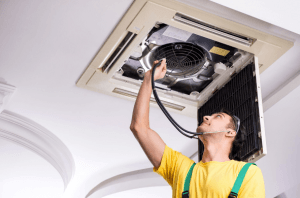Keeping HVAC systems safe is a big deal. If workers aren’t trained properly, it can lead to accidents, system problems, and even legal issues. It’s crucial to ensure everyone working with HVAC systems knows how to do so safely.
A good HVAC safety training program includes several important parts: learning all about safety rules, getting hands-on experience, being taught by experienced teachers, staying updated with new information, and getting certified. This training helps prevent accidents, follows the law, and keeps HVAC systems running well.
In this guide, we’ll discuss why HVAC safety training is so important and what makes a training program work well. We’ll go through everything from the basics of what safety training is to the key parts that ensure your team is prepared and your systems are safe.

What is HVAC Safety Training?
HVAC safety training is an educational program designed to teach technicians about the potential hazards they may encounter while working with heating, ventilation, and air conditioning systems. This training covers various topics, including how to safely install, maintain, and repair HVAC units, the proper use of tools and safety equipment, and the legal safety standards and regulations that must be followed in the industry.
The goal is to ensure that technicians are well-prepared to handle the equipment safely, prevent accidents and injuries, and maintain a safe working environment.
Importance of HVAC Safety Training
Safety training is crucial in the HVAC industry to protect workers, ensure legal compliance, and maintain system efficiency. Here’s why:
Ensuring Compliance
HVAC systems must meet specific safety standards set by local and national regulations. Safety training helps ensure that technicians are aware of these rules and can work in a way that complies with them. This not only avoids legal issues but also ensures that the HVAC system is installed, maintained, and repaired safely and effectively.
Preventing Accidents and Injuries
Working with HVAC systems can be dangerous due to the electrical components, high pressure, and chemicals like refrigerants. Safety training teaches technicians how to handle these hazards, reducing the risk of accidents and injuries on the job. This training covers using tools, protective equipment, and safety procedures to ensure a safe working environment.
Improving System Performance
Well-trained technicians are more likely to install and maintain HVAC systems correctly, leading to better system performance. Safety training includes understanding how different components of the system work together and the potential risks if they are not handled correctly. This knowledge helps technicians to identify and fix issues before they lead to significant problems, ensuring the HVAC system operates efficiently and effectively.
In addition to general safety training, HVAC professionals should also receive specific training related to HVAC safety inspections to ensure they can assess systems thoroughly for potential hazards and compliance with safety standards.
During office holidays, HVAC safety tips become particularly important as offices may experience reduced staffing or altered schedules. Safety training should include guidance on how to handle holiday-related challenges such as ensuring proper ventilation, addressing potential fire hazards, and maintaining system efficiency during periods of lower occupancy.
Furthermore, understanding HVAC compliance audits is crucial as part of safety training. Technicians should be familiar with the audit process, including what auditors look for, how to prepare for audits, and how to address any findings or recommendations from audits to ensure ongoing safety and compliance.
Key Components of Effective HVAC Safety Training Programs
A well-rounded HVAC safety training program ensures technicians have the knowledge and skills to work safely and efficiently. Here are some critical components of an effective program:
Comprehensive Curriculum
The curriculum should cover all aspects of HVAC safety, including the basics of HVAC systems, potential hazards, safe handling of refrigerants, electrical safety, and emergency procedures. It should also address specific regulations and standards relevant to the HVAC industry, ensuring that technicians are up-to-date with their legal responsibilities and best practices in safety.
Practical Hands-On Training
While theoretical knowledge is essential, practical hands-on training is crucial for technicians to apply what they’ve learned in real-world scenarios. This component should include simulations of everyday HVAC tasks and emergencies, allowing trainees to practice and refine their skills in a controlled, safe environment. Hands-on training helps technicians gain confidence and competence in safely managing HVAC systems.
Qualified Instructors
The effectiveness of an HVAC safety training program heavily depends on the instructors’ expertise and ability to teach. Qualified instructors should have extensive experience in the HVAC field and a strong background in safety training. They need to be capable of conveying complex information in a clear and accessible manner, ensuring that technicians of all experience levels can understand and apply the safety principles taught.
Regular Updates and Refresher Courses
To keep pace with the ever-evolving HVAC industry, safety training programs must be regularly updated to reflect the latest standards, technologies, and best practices. Regular updates ensure the training material remains relevant and effective in teaching the current safety protocols.
Refresher courses play a crucial role in maintaining a high standard of safety awareness and competence among technicians. These courses help reinforce previous learning, introduce new safety concepts, and address any bad habits that may have developed. Regularly scheduled refresher training ensures that technicians remain proficient in their safety practices and up-to-date with industry developments.
Certification and Documentation
Certification is a key component of HVAC safety training. It serves as proof that a technician has successfully completed the training and is qualified to work safely with HVAC systems. This certification should be recognized by industry standards and comply with local and national regulations.
Documentation of the training process and outcomes is equally important. It should include detailed records of the training content, the instructors, and the assessment methods, as well as the individual performance and certification of each technician. This documentation helps track the effectiveness of the training program, identify areas for improvement, and provide evidence of compliance with safety regulations and standards.

